THE COTTON BELT IN CARROLLTON
PART TWO: A RAILFANíS PERSPECTIVE 1995-1996
Click here for Part One
By Ira Glen Williams
Changes in our geographic location almost invariably bring changes in our life experience. Such was the case with me, when during the summer between my Junior and Senior years in High School, a move took me from living in Dallas to living in Carrollton. That was the summer of 1995, and I was already a Cotton Belt fan. I had discovered the St. Louis Southwestern Railway by accident some years earlier, a coincidence arising from my motherís ceramic business involving her in a craft fair held on the streets of downtown Carrollton. I donít recall what year that was, but I distinctly recall walking with Dad from her display area some little distance northward to the Cotton Belt-Katy diamond, seeing the depot, and watching a train crew use a red-and-gray locomotive to spot some freight cars as they performed some local switching. One of the sounds which stuck in my mind was the brake hoses popping loose when the crew lifted the coupler cut lever and pulled away from a freight car, leaving the brake hoses to disconnect when pulled apart with a loud bursting sound. While prowling around watching the action, I have a very clear memory of spotting a sign with the railroad name listed, and thinking aloud, ďSt. Louis Southwestern, whatís that?Ē During what I believe was that same weekend, I observed a Burlington Northern SD40-2 running northbound on the old Frisco line with an intermodal train made up mostly of 89-foot flat cars. The weekend ended, and I continued life as a generic train nut.
My true conversion into a dedicated Cotton Belt fan occurred some years later in October of 1992 as the result of riding along with one of my cousins in pursuit of steam locomotive Number 819 as it left Tyler on a return trip to Pine Bluff. So, somewhat less than three years into my newly focused interest in a specific railroad, I found myself living in a suburb where my favorite railroad operated. At the time, I was interested in seeing the Cotton Belt and the equipment operating on the line, but there was no real sense of urgency to my efforts to familiarize myself with either. That all changed when my brother-in-law came in one day and informed me he had heard the Union Pacific was paying $5.4 billion for a twenty or twenty-five percent interesting in the Southern Pacific and Cotton Belt. This version of the story, as we all know now, was not quite right, and in fact as more information became available, it was apparent that full ownership of the entire Southern Pacific/Cotton Belt/Denver & Rio Grande Western system was the Union Pacificís goal. As any informed railfan would have known, it also implied an impending repaint of the beloved red-and-gray locomotive fleet into Armour Yellow and Harbor Mist Gray.
So through the winter of 1995-1996 and into the spring, my newly formed habit of railfan photography had a distinct purpose: to get photos of Cotton Belt and Southern Pacific equipment operating in Carrollton while there was still time. The 1924 Carrollton union depot was at that time still in its original location at the southeast corner of the Cotton Belt-Katy diamond, a block or so east of Interstate 35 E and a little north of Belt Line Road. I recall the depot having a faded appearance, as if it had not been painted in quite a few years. The photos I took of it confirm the accuracy of that recollection. A state historical marker located across the Katy track from the depot on the buildingís west side gave a rather abbreviated history of the railroads operating through Carrollton. Tower 77, which had been located across the Cotton Belt track north of thedepot, was long gone, and a concrete signal box stood at the location. Cotton Beltís small yard, really just a broad place in the track located east of the diamonds was present, as was the one piece of track which drew most of my attention. This was a short spur, located west of the diamonds on the north side of the Cotton Beltís branch, with the switch tying it to the branch on the west end, almost under the I-35 overpass. This was the place where local crews always seemed to park whatever locomotives Cotton Belt had stationed in Carrollton when they were not being used. This meant there was normally something parked on this spur which was well worth a photograph from my 35 millimeter camera. West College Street paralleled this spur on its north side, providing a publicly accessible place for a railfan photographer to easily and safely position himself near the equipment of interest and take pictures.
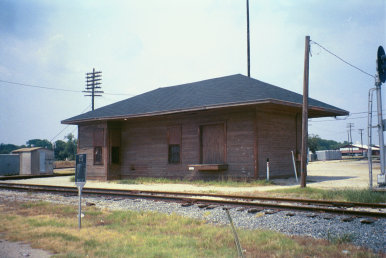
|
Carrolltonís third union depot, built in 1924, looks pretty weather-beaten circa 1995-1996. This view shows the west side of the depot, with the Katyís (by then Union Pacificís) Dallas-to-Denton line in the foreground, and the Cotton Beltís Fort Worth Branch visible between the depot and the signal box at left. The signal box is at the approximate former location of Tower 77. The Cotton Belt-Katy diamond is just out of sight to the left of this view. |
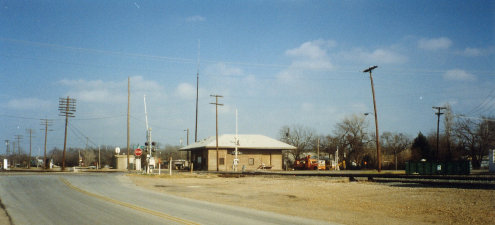
|
This photograph, also taken circa 1995-1996, looks roughly east southeast across West College Street. The Carrollton union depot is visible across the tracks in the distance. Sharp eyes can spot the signal box just beyond the stop sign near the former location of Tower 77 and the wheel stops on the end of the spur track between the street and the Cotton Beltís Fort Worth Branch to the right. This spur was Cotton Beltís favorite place to park locomotives between assignments. |
The Cotton Belt typically had a few locomotives in Carrollton in the late 1980ís and into the 1990ís for local operations. The opportunities for local railfans to photograph locomotives would persist on through the late Cotton Belt era and beyond. Two events in the 1990ís, however, altered operations on the Fort Worth Branch, and made Carrollton a focal point for traffic going to or from the western end of the line as well as, strangely, Sherman/Denison on the Southern Pacific. Those of you familiar with Cotton Belt history in this part of the state will quickly recall that in the spring of 1990 a flood washed out the Fort Worth Branchís crossing over the Elm Fork of the Trinity River timetable east of Wylie and just downstream from the Lake Lavon dam.1 Southern Pacific, rather than authorizing expenditures to repair the damage, used this event as an opportunity to close the affected section of the line between Greenville and Wylie.2 At some point prior to its own sale to Union Pacific, the Southern Pacific sold the Dallas-to-Plano segment of its Ennis Subdivision to Dallas Area Rapid Transit (ďDARTĒ). Cotton Belt had utilized trackage rights over that portion of SPís Ennis Subdivision to operate into Dallas since its own branch from Addison to Dallas was abandoned in 1965 to make way for construction of the Dallas North Tollway.3 When DART began the reconstruction process of converting this Dallas-to-Plano trackage to light rail for commuters, it was permanently closed for freight operations. These two events combined would appear to have left the western portion of the Cotton Beltís Fort Worth Branch isolated from the remainder of the railroad, but with customers still needing rail service.
This problem was avoided when trackage rights were obtained up the former Katy line from Dallas to Carrollton, which since 1988 had been owned by the Union Pacific. At Carrollton, trains could cross between the ex-Katy line and the Cotton Beltís Fort Worth Branch by utilizing the connector track between the two routes on the southeast quadrant of the Cotton Belt-Katy diamond. Construction of this connector track was referenced in Part One of this article. This resulted in a route connecting the Fort Worth Branchís isolated western section to Southern Pacificís Miller Yard in Dallas. As the point where the outside world could be accessed, Carrollton remained a logical place to park locomotives assigned to serve Cotton Beltís customers in the area. As a result of the sale of the Dallas-to-Plano section of the Ennis Subdivision, all traffic to and from the northern end of the Ennis Subdivision (Plano to Sherman/Denison) was also rerouted via Carrollton, then east across the Cotton Belt to Plano, where it reentered Southern Pacific trackage for points north. SP normally kept a locomotive, almost invariably a GP40-2 or a rebuilt GP40M, and a bay window caboose parked in Plano during this time period.
During the fall semester of 1995, each student in my grade at the school I attended was required to recruit a mentor to help teach the student some new skill. I chose to learn the art of detailing HO Scale locomotives, and recruited my closest railfan friend as my mentor. While we worked together to ensure that I learned the art of detailing HO Scale locomotives by working on a model of Cotton Belt GP60 Number 9664, and in the months after its completion, I was also attempting to photograph whatever prototypes the Cotton Belt made available for railfan photographers in Carrollton. Unfortunately for some of the photographs I took during this time, I hadnít quite mastered the understanding of proper light angles needed to ensure good quality photographs. As a result, several of the photos from the area during this time are rather backlit. Two of my favorite photos, though, turned out acceptably.
I drove down to West College Street one day and parked to watch the action. The local crew had just finished some switching work utilizing Southern Pacific MP15AC Number 2711, which wore a somewhat faded version of the Bloody Nose scheme with Southern Pacific stack lettering. Parked on the most interesting spur south of the street were two locomotives, Cotton Belt 7292, a Morrison-Knudsen rebuilt GP40M, and Denver & Rio Grande Western 3060, a GP40 in the Grandeís classic black-and-gold. As the crew moved the 2711 to park it on the spur with the other two locomotives, I clicked off a few photos.
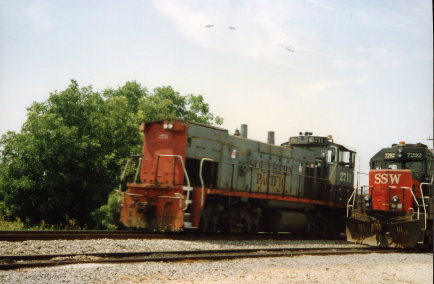
|
Stack-lettered Southern Pacific MP15AC Number 2711, moving westbound backwards on the Fort Worth Branch at Carrollton, glides past Cotton Belt GP40M Number 7292, which is resting on the spur south of West College Street. The 2711 was built new for Southern Pacific in August of 1975. The blank area on the hood end where most of the light cluster has been removed is a sign of changing times on the Southern Pacific. In just a moment, the crew will park the 2711 on the west end of the spur.4 |
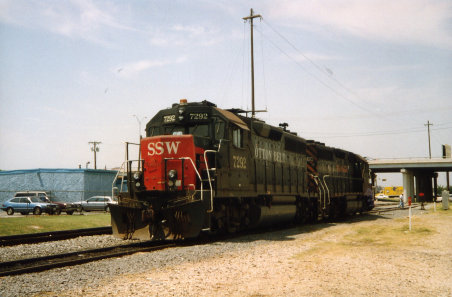
|
In this view looking roughly southwest, Cotton Belt GP40M Number 7292 and Denver & Rio Grande Western GP40 Number 3060 rest on the spur along West College Street. The bridge in the background carries Interstate 35 E over West College Street and Belt Line Road. The 7292 was originally built in March of 1971 as Baltimore & Ohio GP40 Number 3777. When merger included the B&O in CSX, the unit received a new road number, becoming CSX 6552. Morrison-Knudsen rebuilt twenty GP40ís for the Cotton Belt during the winter of 1990-1991, and this locomotive emerged in January of 1991 as Cotton Belt 7292. In a move likely inspired by Rio Grandeís use of the technology, all twenty Cotton Belt rebuilds were fitted with Positive Traction Control, a wheel-slip control system meant to eliminate the slipperiness of the original GP40 design. Because of the increased pulling power this gave them, these units were sometimes called ďSuper GP40sĒ, although their horsepower rating remained at 3,000. They were equipped with ditch lights, Dash Two electrical cabinets, rotary beacons, cab air conditioning, standard SP-style snow plows, and 3.600 gallon fuel tanks. For the protection of the crewís hearing capacity, the horns were relocated to the long hood where they were placed between the first and second radiator fans.5 |
I would return to Carrollton a few times throughout the coming months to take photos and see what was there. It seemed that after that first visit, Southern Pacific locomotives dominated the scene. In fact, looking back through my photos from that time period, I donít see any photos of Cotton Belt locomotives in Carrollton other than the 7292. Rebuilt GP40ís and GP40-2ís have long been one of my favorite locomotive types, possibly due to my memory of the 7292. For whatever reason, and despite the fact that I never saw it again, the 7292 became something of a favorite of mine among Cotton Belt locomotives. Some years later, in the early 2000ís, when Atlas ran a model of the 7292, I made sure to add one to my HO Scale collection. It still serves me well a decade later.
Seeing a locomotive from a ďforeignĒ railroad (meaning anything other than Southern Pacific, Cotton Belt, or Denver & Rio Grande Western) on Cotton Belt trackage in Carrollton was a truly rare event for me during 1995-1996, but one railfanning expedition brought me in contact with Seaboard System GP38-2 Number 2582. I found the locomotive parked at the west end of Cotton Beltís small yard, really a broad place in the track east of the depot. Fortunately, I had the sense to snap a photo. I also took a photo on the one occasion I can recall seeing a General Electric unit in Carrollton.
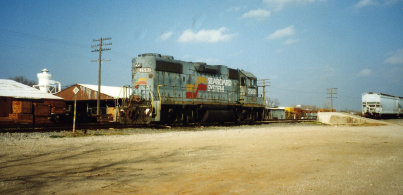
|
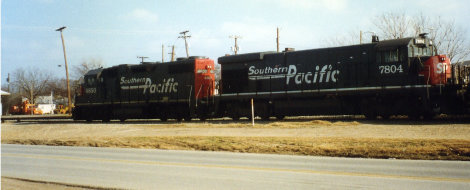
|
| Seaboard System GP38-2 Number 2582 rests at the west end of Cotton Beltís ďyardĒ in Carrollton circa 1995-1996. The appearance of Seaboard System paint this many years into the CSX era indicates itís been some time since this locomotive was last painted. The lumber business in the background was a Cotton Belt customer with its own spur. | Southern Pacific locomotives seemed to me to be more common than Cotton Belt power in Carrollton during 1995-1996. In this scene at the West College Street spur, we see GP38-2 Number 4850 and B30-7 Number 7804. The 4850 is the only SP GP38-2 I ever recall seeing in Carrollton. The 7804 is likewise the only SP General Electric unit I recall seeing there. The 4850, rated at 2,000 horsepower and originally built as Louisville & Nashville 4075, was leased long-term by SP from Helm Financial Services while the 3,000 horsepower 7804 was built new for Southern Pacific in March of 1978.6 Sharp eyes can spot the flat sheet metal covering the former location of 7804ís oscillating headlights between the number boards above its windshield. |
A few months after the photos in this article were taken, the Union Pacific took control of the Southern Pacific and the Cotton Belt, forever changing the railroad scene in Carrollton. I donít have any memories of photographing Union Pacific power there, and my interest in the place waned until the coming of the Dallas, Garland & Northeastern Railroad which took over operation of the Carrollton-Plano segment of the Fort Worth Branch from the Union Pacific a couple of years later. After two moves, I ended up living in a different suburb some distance from Carrollton, and I fell out of the habit of railfanning in Carrollton in favor of other explorations which brought Plano and the remaining northern portion of the old Southern Pacific Ennis Subdivision under my scrutiny. The short time in which I was able to experience the Cotton Belt in Carrollton left me with some good memories and some now treasured photos.
- Goen 104
- Oral Presentations at the Cotton Belt Symposium, 2010
- Goen 100
- Construction date of Southern Pacific MP15AC 2711 taken from Limas, p. 105
- Technical data concerning SSW 7292 taken from Limas, pp. 38-39, 120
- Technical data concerning SP 4850 taken from Limas p. 113. Technical data concerning SP 7804 taken from Limas p. 126.
- Goen, Steve Allen. Cotton Belt Color Pictorial
La Mirada, California: Four Ways West Publications. - Cotton Belt Symposium. Texas A&M University at Commerce. Commerce, Texas, 2010.
- Limas, Peter. Southern Pacific Rails: A Motive Power Finale
Hart, Missouri: White River Productions, 1998